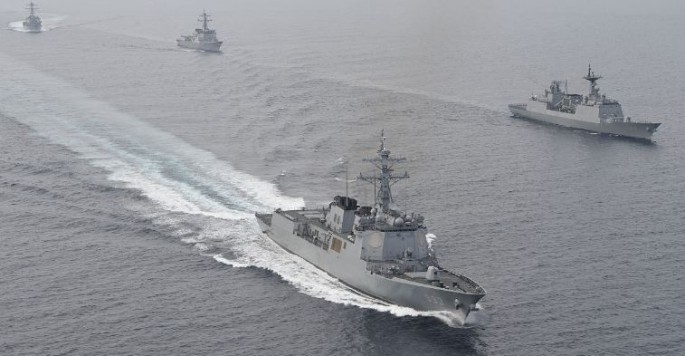The United States and the Republic of Korea put on their mightiest show of force by sending their warships to flaunt their power off the east coast of North Korea in another message they hope North Korean dictator Kim Jong Un will finally take to heart.
The U.S. Navy and the Republic of Korea Navy (ROKN) sent a small fleet of guided missile destroyers of the U.S. Arleigh Burke-class plus submarines and planes to operate in international waters just off the east coast of North Korea. The North Koreans did not interfere with the naval exercise meant to show U.S. and South Korean might and unity in the face of North Korean provocations.
Notable in this exercise in the East China Sea was the presence of the Arleigh Burke-class destroyers in both navies equipped with the U.S.-built Aegis missile defense system. The Aegis system, which exists only aboard warships, can track more than 100 aerial targets at a time and is the only naval system capable of intercepting ballistic missiles.
Its maker, Lockheed-Martin, claims Aegis "is the world's most advanced combat system. Once North Korean ballistic missiles are detected headed for South Korea, Arleigh Burke-class destroyers from either the U.S. Navy or the ROKN can intercept them with RIM-161 Standard Missile 3 (SM-3) missiles built to defeat short and medium range missiles at high altitudes.
Or, the allies can use a RIM-174 Standard Extended Range Active Missile (ERAM), otherwise known as the Standard Missile-6 (SM-6), to destroy targets flying beyond the horizon.
The show of force on Sept. 26 was the first naval display of allied naval power in the ongoing crisis that's seen North Korea successfully test a submarine launched ballistic missile (SLBM); three medium range ballistic missiles; a new rocket engine, as well as a 10 kiloton nuclear bomb over the past two months.
The spate of successful tests is particularly worrisome to South Korea, which fears the north might soon fit nuclear warheads onto its ballistic missiles. This fear led Seoul to announce this month it will obliterate the North Korean capital of Pyongyang -- and do all it can to kill Kim Jong Un -- in a hail of artillery and missile fire should it detect incoming North Korean missiles.
South Korean intelligence said North Korea is progressing toward its goal of mounting nuclear warheads on its ballistic missiles "faster than previously estimated."
The naval show of force followed last week's flight of U.S. Air Force B-1B Lancer supersonic bombers along the Demilitarized Zone (DMZ) dividing North and South Korea. This flyover was closest the Air Force has ever flown its bombers to the DMZ.
One of the B-1Bs later landed on a South Korean military air base. The B-1Bs came from Andersen Air Force Base in Guam, which is two flying hours away.
Earlier this month, B-1Bs flew over Osan Air Base south of Seoul in response to North Korea's fifth test of a nuclear warhead. North Korea later boasted this test shows it can mount nuclear warheads on its ballistic missiles.
"Our ROK-US alliance will counter the North Korean nuclear development and SLBM threats with determination," said Vice Adm. Lee Ki-sik, commander of the Republic of Korea Fleet.



























